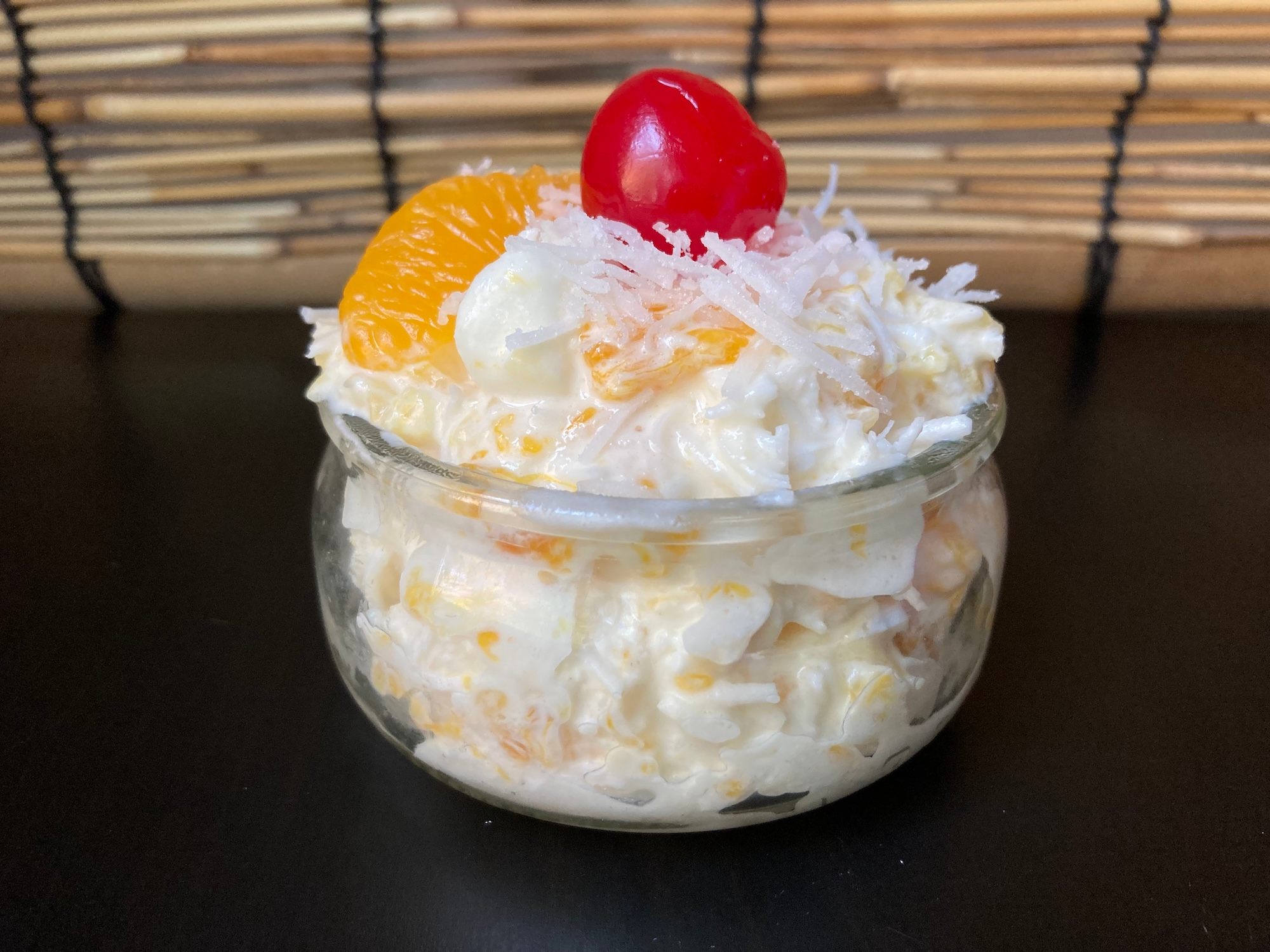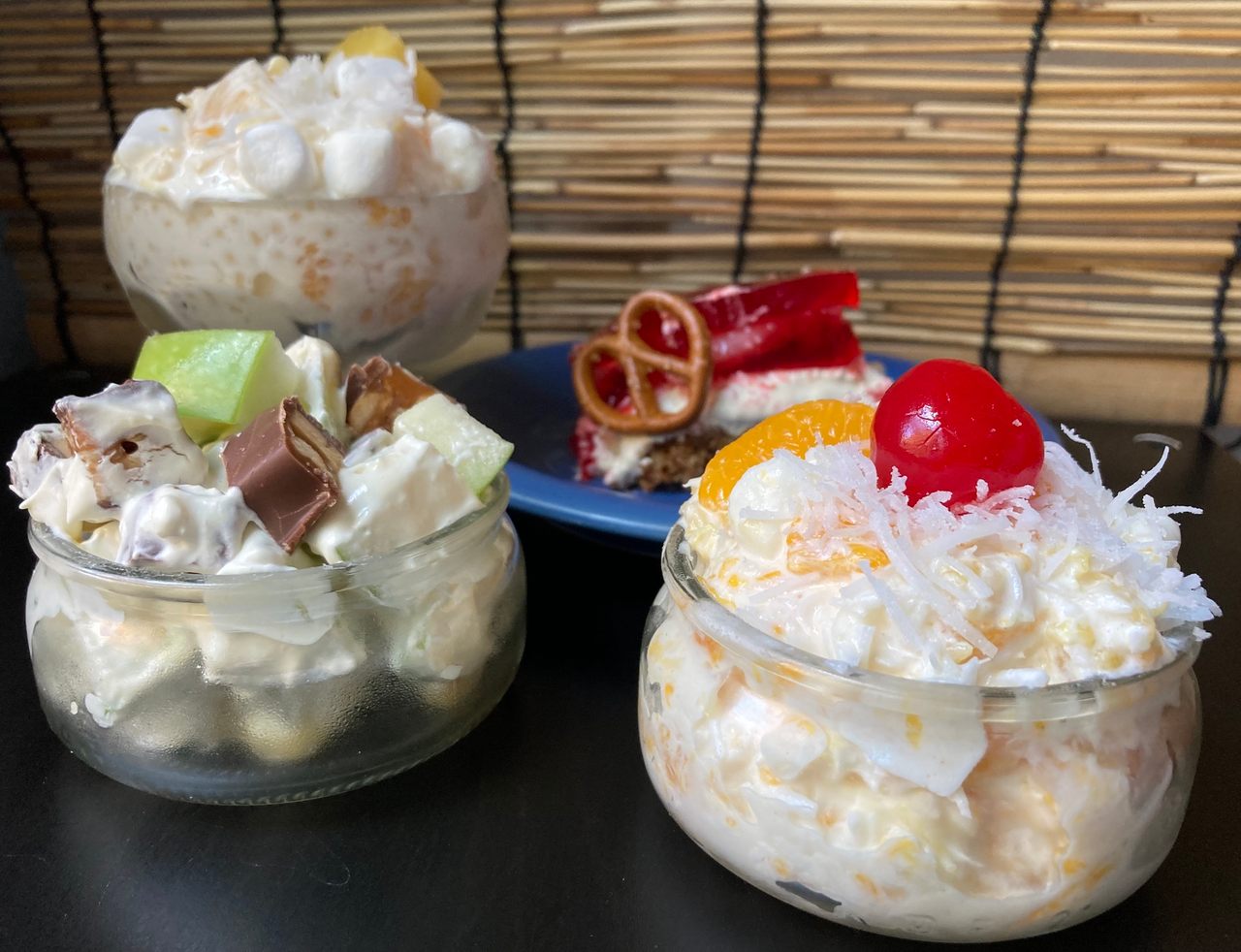The Glorious World of Sweet Holiday Salads
Cool Whip and Jell-O for everyone!
This article is adapted from the November 18, 2024, edition of Gastro Obscura’s Favorite Things newsletter. You can sign up here.
When I recently Googled “Thanksgiving salad,” the results were recipes for vibrant, fresh vegetable mixtures, thoughtfully tossed with seasonal nuts and savory dressings.
This was not what I wanted to see. Googling “Thanksgiving salad with Cool Whip,” on the other hand, delivered the recipes I was looking for: the fanciful sweet salads that 20th-century Americans concocted out of Jell-O, canned fruit, and whipped topping.
Every Thanksgiving, my grandma Lois made her cherry Jell-O salad, studded with fruit cocktail and chunks of banana, with a layer of sour cream in the middle. It’s now my job to make it each Thanksgiving. It just wouldn’t feel right not to have a slab of red Jell-O on my plate, slowly staining the mashed potatoes pink.
Despite their sweetness, these salads have never been relegated to the dessert table in my family. That seems to be the case with many other households as well, but it’s often an unspoken rule. Restaurant critic MacKenzie Chung Fegan wrote about how she felt like she had committed a “culinary gaffe” when she hosted Thanksgiving and offered to set her sister-in-law’s raspberry Jell-O and whipped-cream “salad” next to the pies.
This misunderstanding happened for a reason. Sweet salads are often made with pudding mix, gelatin, whipped topping, canned fruit, and sugar. These ingredients were increasingly available in the early 20th century, so home economists and food brands had to find ways for the home cook to use them. As Sylvia Lovegren writes in Fashionable Food: Seven Decades of Food Fads, coating canned fruit and vegetables in creamy sauces or gelatin was once considered modern, hygienic, and elegant. In this way, “messy, primitive salads” could be made uniform and easy to eat. Food trends change, of course, and sugary salads are now nostalgic family recipes rather than cutting-edge dinner party fare. Their former status, though, may be why so many people have held on to these concoctions as holiday specialties.
In 2014, the New York Times published an article called “The Thanksgiving Recipes Googled in Every State,” where they listed the most distinct dishes—not the most popular—searched for across the country. The number of sweet salads on the map delighted me, and sparked an idea.
So I decided to whip up four of the nation’s most beloved sweet salads. Would they beat out my grandmother’s fruit-cocktail concoction? There’s was only one way to find out.
Snickers Salad

I started my salad adventure by chopping up a Snickers bar. Snickers salad is on the simpler side, consisting of chopped Snickers and green apples glued together by a creamy combination of vanilla pudding and Cool Whip.
Like most sweet salads, no one knows exactly who invented it. It’s especially popular in the upper Midwest; Gastro Obscura writer Ike Allen notes that it can be found “in regions of heavy Lutheran and Scandinavian heritage from Indiana to North Dakota.”
So does it really deserve the name “salad”? Maybe not, but the recipe I tried was an undeniably tasty mixture of refreshing fruit and chewy candy. Some people even go further and add a caramel drizzle to the top of their salad, but, I’ll admit, I skipped that step.
Strawberry Pretzel Salad

This salad actually starts out in the oven. First, you briefly bake a crust out of crushed pretzels, butter, and sugar, then allow it to cool completely. Then, you spread on a thick coat of cream cheese and Cool Whip, and top it with a shining layer of red Jell-O and strawberries. The result is sweet and creamy, with a malty crunch from the pretzel crust.
The history of pretzel salad is convoluted. Food historian Kara Mae Harris notes that a number of sources mistakenly attribute the recipe to a Jell-O cookbook published in 1963, but the dish had appeared in even earlier books.
What’s certain is that Pittsburgh particularly loves pretzel salad. The internet abounds with people from the surrounding region relating their childhood love of the dish, and there’s even a yearly Strawberry Pretzel Salad Standoff where businesses compete to make the best versions and variations of the treat. The United Steelworkers union, whose headquarters is located in Pittsburgh, even have a recipe for the salad on their website. It does make sense that a salad involving pretzels would be a local favorite, considering how many Pittsburghers claim German ancestry.
Ambrosia

Confession time: Before this project, I had never tried ambrosia. Sure, I knew about it: It’s still a popular holiday food, and it’s mentioned a lot in food-history books because of its charming name and for its status as an American classic. But does “the food of the gods” actually live up to its title?
There are a number of different recipes out there, but the general concept is always the same: canned pineapple, mandarin oranges, shredded coconut, and marshmallows, bound together with a gooey substance such as Cool Whip or sour cream. I followed this recipe and let the mixture sit overnight to marinate, but I found myself sneaking spoonfuls throughout the evening. Ambrosia really is that good.
Ambrosia has been around for quite a while. The earliest known recipe dates to 1867, and consists of oranges and grated coconut sprinkled with sugar. According to The Oxford Companion to Sugar and Sweets, it is a particular favorite in the South, “most likely due to the South’s fondness for sweets.” But of course, it’s classified as a salad, not a dessert.
Frog Eye Salad

Frog eye salad doesn’t include frogs. It does include pasta, but it’s not savory. I had never cooked acini di pepe pasta before, and perhaps you haven’t either. Instead of noodles or bows, they’re shaped like tiny spheres. To make them into a sweet salad, you cook them until soft, rinse, then mix them with vanilla pudding or homemade custard, Cool Whip, fruit, shredded coconut, and marshmallows.
The result? A dessert with a flavor profile like ambrosia but a texture reminiscent of tapioca pudding. I can understand how the pasta shape could evoke the idea of frog’s eyes, but frog eye salad is a shocking name for a pretty normal dish. The name doesn’t stop it from being popular, though. In Utah, it’s a common sight at events held by members of the Church of Jesus Christ of Latter-day Saints. In fact, salads involving canned fruit and gelatin are especially beloved in LDS circles.
There are a number of theories out there as to why: Some writers posit that the group’s prohibition of caffeine and alcohol made sugary treats the main way to get a tasty thrill. Others note that Utah’s high birth rate and the LDS’s focus on family made the region a perfect market for advertising sweet ingredients and dishes that both children and adults could enjoy.
Salad Days
So, will I be swapping out Grandma Lois’s Jell-O salad for ambrosia this year? Probably not. All the salads I sampled were delicious in their own way, but they were all too rich to be a good counterpoint to the other dishes my family makes every year, each with their own names and stories. So I’ll be taking the usual crystal bowl of layered red Jell-O to Thanksgiving—and it will sit next to the gravy and stuffing.
But I had lots of fun whipping up these sweet sides. One of the best parts was browsing recipes with the same names and seeing the unique spins people put on their ambrosia or frog eye salads. Some people are out there adding nuts, spices, extra fruit, and all kinds of frills to these dishes. Often, they write, it’s the way their grandmother used to make it.
Gastro Obscura covers the world’s most wondrous food and drink.
Sign up for our regular newsletter.

























Follow us on Twitter to get the latest on the world's hidden wonders.
Like us on Facebook to get the latest on the world's hidden wonders.
Follow us on Twitter Like us on Facebook